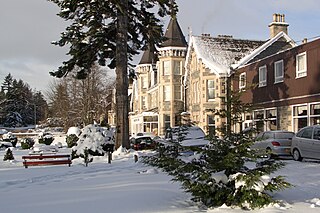
Grantown-on-Spey is a town in the Highland Council Area, historically within the county of Moray. It is located on a low plateau at Freuchie beside the river Spey at the northern edge of the Cairngorm mountains, about 20 miles (32 km) south-east of Inverness.

The Great Glen, also known as Glen Albyn or Glen More, is a glen in Scotland running for 62 miles (100 km) from Inverness on the edge of the Moray Firth, in an approximately straight line to Fort William at the head of Loch Linnhe. It follows a geological fault known as the Great Glen Fault, and bisects the Scottish Highlands into the Grampian Mountains to the southeast and the Northwest Highlands to the northwest.
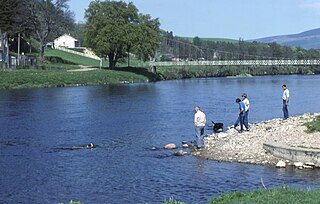
The River Spey is a river in the northeast of Scotland. At 98 mi (158 km) it is the eighth longest river in the United Kingdom, as well as the second longest and fastest-flowing river in Scotland. It is important for salmon fishing and whisky production.
The Strathspey Railway (SR) in Badenoch and Strathspey, Highland, Scotland, operates a ten-mile (16 km) heritage railway from Aviemore to Broomhill, Highland via Boat of Garten, part of the former Inverness and Perth Junction Railway which linked Aviemore with Forres. It is one of only a handful of former primary/secondary main lines to be preserved in Britain today.

The A95 road is a major road of north-east Scotland connecting the A9 road in the Highlands to the A98 road near the coast.
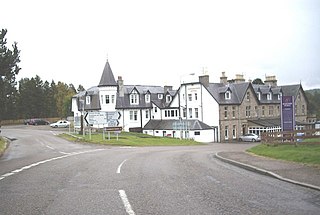
Carrbridge is a village in Badenoch and Strathspey in the Scottish Highlands. It lies off the A9 on the A938, west of Skye of Curr and southeast of Tomatin, near Bogroy. It has the oldest stone bridge in the Highlands and the nearby ancient pine forest contains the Landmark Forest Adventure Park.
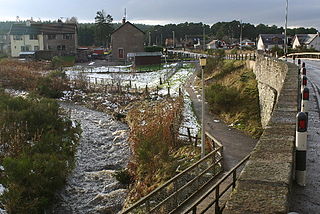
Cromdale is a village in Strathspey, in the Highland council area of Scotland, and one of the ancient parishes which formed the combined ecclesiastical parish of Cromdale, Inverallan and Advie in Morayshire.

Dulnain Bridge is a village in Strathspey, next to the meeting of the River Dulnain and the River Spey, three miles south-west of Grantown-on-Spey, in the Scottish Highlands and the Highland council area.

Achnahannet is a hamlet located northwest of Dulnain Bridge, and three and a half miles west-south-west of Grantown-on-Spey, in the historical county of Morayshire, now in the Highland Council area, Scotland. Historically it belonged to the parish of Cromdale.
Grantown-on-Spey (West) railway station was opened with the Inverness and Perth Junction Railway in 1863. Originally appearing on timetables as 'Grantown', the name was changed by British Railways. At the same time, the former GNSR station 'Grantown-on-Spey' was renamed similarly as 'Grantown-on-Spey (East)'.

The River Fiddich is a right bank tributary of the River Spey in northeast Scotland. It rises on the eastern slopes of Corriehabbie Hill in Glenfiddich Forest and flows northeastwards beneath the A941 road, past Auchindoun Castle to a sharp bend adjacent to the A920 road where it turns westwards to flow to Dufftown. The Fiddich is joined on the eastern edge of the town by the Dullan Water which drains Glen Rinnes. Their combined waters then flow generally northwestwards, passing beneath the B9014 road near Balvenie Castle and then the A95 at Craigellachie immediately before meeting the Spey.
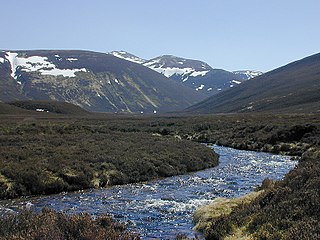
The River Nethy is a right bank tributary of the River Spey in northeast Scotland. It rises as the Garbh Allt between Cairn Gorm and A' Chòinneach on the northern slopes of the Cairngorms and flows northwards through Strath Nethy and into Abernethy Forest. Passing through Nethy Bridge where the B970 road crosses the river and gives its name to the village, the Nethy turns northwestward before entering the Spey at Broomhill. Numerous burns feed the Nethy, the most significant of which is the Dorback Burn which enters from its right bank a mile above Nethy Bridge.

The River Feshie is a major right bank tributary of the River Spey in north-east Scotland. It rises in the remote countryside of the Glenfeshie Forest, flowing initially eastwards before turning sharply to the northwest as a result of the capture of the waters of Geldie Burn. After gaining the waters of the River Eidart on its right bank and dropping down into Glen Feshie, it flows northwards through the wooded glen and is often braided in nature. It is joined by several burns which descend steeply from the Cairngorm plateau to the east and, on its left bank, by the Allt Chomhraig near Balachroick. The river passes beneath the B970 road at Feshiebridge and after a further 1.5 miles (2.5 km) it joins the Spey near the village of Kincraig.

The River Druie is a right bank tributary of the River Spey in northeast Scotland. The Druie tributaries are Am Beanaidh, which emerges from Loch Einich and flows north through Gleann Einich; and the River Luineag, which emerges from Loch Morlich within the Glenmore Forest Park and receives all the drainage from the northern slopes of Cairn Gorm. These meet immediately above the bridge carrying the B970 road over the river at Coylumbridge. From this point the Druie flows 1.5 miles (2.5 km) past Inverdruie to meet the Spey at the southern end of Aviemore.

The River Tromie is a right bank tributary of the River Spey in northeast Scotland. It emerges from the northern end of Loch an t-Seilich within the Gaick Forest and flows northwards, then northwestwards down through Glen Tromie to Bhran Cottage where it turns to the north-northeast. It is bridged by the B970 road at Tromie Bridge near Drumguish and flows a further 1.25 miles (2 km) northwest to meet the Spey near Lynchat.

The River Calder is a left bank tributary of the River Spey in the Scottish Highlands. Its headwaters are the an t-Allt Ballach, Allt an Lochain Dubh and Allt Madagain which drain the mountain slopes at the southeastern corner of the Monadhliath. Their waters are added to by those of the Allt Fionndraigh and Allt a' Chaorainn dropping down into Glen Banchor from the north. The river turns southeastwards and skirts the western edge of Newtonmore, running beneath the A86 road before joining the Spey at Spey Bridge.

The River Nairn is a 35 mile long river in the Scottish Highlands.

Duthil Old Parish Church and Churchyard is a historic site at the centre of the historical parish of Duthil near Carrbridge in Inverness-shire, in the Scottish council area of Highland. It is now maintained as a Clan Grant Heritage Centre.

The Lairig an Laoigh is a mountain pass through the Highlands of Scotland. In speech and sometimes in writing the name is reduced to "Lairig Laoigh". It is of glacial origin, dissecting the Cairngorm plateau, and it runs roughly north–south from Speyside to Deeside at one time being used as a drove road. Between the public road in the Abernethy Forest and the one at Linn of Dee the trekking distance is 31 kilometres (19 mi).

The Carron Bridge is a bridge at Carron in Moray, Scotland, which crosses the River Spey between the parishes of Knockando and Aberlour. It was built for the Strathspey Railway in 1863, to a design by Alexander Gibb, an engineer for the Great North of Scotland Railway, and fabricated by the iron founders William McKinnon and Co. It originally carried both the railway and a roadway, but the railway has now closed.


















